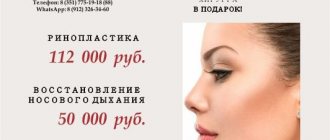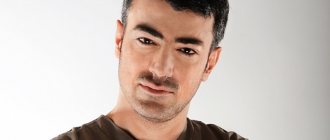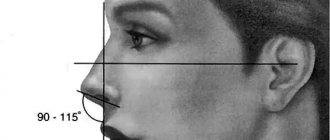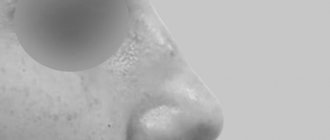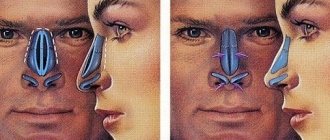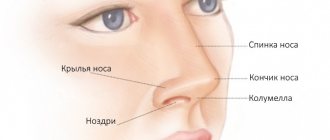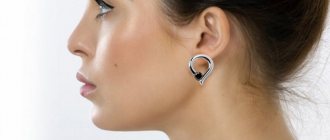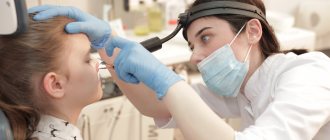Rhinoplasty is the correction of congenital or acquired deformities of the nose. The task of plastic surgery is to restore the correct forms that were disrupted at the stage of embryogenesis or as a result of any diseases or mechanical (traumatic) damage during life, often in combination with the restoration of correct nasal breathing.
Today, rhinoplasty is in great demand among patients. From a technical point of view, this is one of the most difficult operations, requiring high professionalism of the doctor and highly developed aesthetic taste.
How to treat hemorrhoids with laser?
Minimally invasive laser surgery for hemorrhoids does not require anesthesia or incisions. The procedure involves identifying the terminal branches of the rectal artery using Doppler, followed by photocoagulation of these branches using a diode fiber laser (1470 nm). Laser treatment of hemorrhoids does not require general anesthesia; local administration of local anesthetics is sufficient. It is highly effective and has a painless postoperative period.
Laser cauterization is a method in which the surgeon burns swollen hemorrhoids. Alternatively, the surgeon may use a narrow laser beam to focus only on the hemorrhoid and avoid damaging nearby tissue. It is a safe procedure with minimal bleeding and fast healing time.
A laser fiber is passed through the anus and laser energy is applied to the hemorrhoidal mass. The controlled radiation of laser energy reaches the submucosal area, causing contraction of the hemorrhoidal mass. Reconstruction of fibrosis creates new connective tissue, ensuring that the mucosa adheres to the underlying tissue, preventing recurrence of prolapse.
Treatment of hemorrhoids with laser
Guaranteed results: No pain, no incisions
Call +7
RHINOPLASTY - NOSE PLASTYRhinoplasty, or nose job, is one of the most complex branches of plastic surgery and involves changing the outer contours of the nose by smoothing, removing or moving the bones and cartilage that form its base. Rhinoplasty can reduce or increase the size of the nose, change its shape, and correct birth defects and breathing problems. Who is rhinoplasty indicated for ? Rhinoplasty can be performed for both aesthetic and therapeutic purposes. There are no special restrictions on this procedure, however, it is believed that it is undesirable to do rhinoplasty until the process of facial formation is finally completed (by the age of 14 for girls, a little later for boys). Planning your surgery During your consultation, your surgeon will assess the structure of your nose and discuss your options with you, explaining factors that may affect your surgery and the final outcome. These factors include the structure of the nasal bones and cartilage, the shape of the face, the thickness of the skin, and age.
During the examination, a series of photographs will be taken that are necessary to draw up a surgical plan, as well as an X-ray examination of the paranasal sinuses.
If you have had any surgery or injury to your nose before, or if you have allergies or breathing difficulties, be sure to report this. Issues related to smoking and taking medications should be specifically addressed. For 2-3 days before the operation, it is necessary to take medications to strengthen the walls of blood vessels (ascorutin). The surgeon should give you recommendations as you prepare for surgery. In case you have any questions, be sure to discuss them.
Carrying out the operation
Rhinoplasty is performed only in a hospital setting under general anesthesia in combination with local infiltration anesthesia. The operation usually lasts 1.5-2 hours, although more complex procedures may take longer. The operation consists of separating the skin of the nose from the bones and cartilage, which will be brought to the desired shape. After this, the skin is restored. Some surgeons perform rhinoplasty from the inside, making an incision on the inside of the nostrils. In difficult cases, the “open” method is preferable, when a small incision is made across the nose.
The minimum inpatient stay is usually 1-3 days, depending on the extent of the surgical intervention. Postoperative period To stop bleeding after surgery, tampons are inserted into the nose, which are removed after 2-5 days, during which the patient breathes through the mouth. In many cases, special plates (protectors) made of soft polyurethane are inserted into the nasal passages to hold the nasal septum in the correct position. The protectors are not visible and are removed 3 weeks after surgery. After the operation, a plaster (sometimes with the addition of plaster strips) bandage is applied to the face, which is removed after 7-10 days. The first dressing is done the next day after the operation. There is always swelling and discoloration of the skin (bruising) around the eyes, which disappear by 90% within two weeks. Tissue swelling completely disappears over a longer period (up to 6 months). The time when the patient can return to his daily activities is determined by his well-being. This usually becomes possible within 5-7 days after surgery. In many cases, it is strongly recommended that you avoid wearing glasses for 2-4 weeks after surgery, as this can significantly worsen the outcome. For rapid restoration of nasal tissue (reduction of swelling, bruising, restoration of skin sensitivity, elimination of nasal congestion), it is recommended to carry out physiotherapeutic procedures (EF, UHF, electrophoresis, ultrasound) for a year (3-4 courses). It is also advisable to see your doctor monthly. Preliminary results of the operation can be assessed in 1.5 months, final results in 1-1.5 years.
Closing anal fistulas with laser
This is a minimally invasive and sphincter-sparing method used in the treatment of anorectal fistula. The fistula tract is covered with epithelium, so it never heals on its own. Using a laser, the epithelium is destroyed and sealed. To do this, a radial light guide is installed inside the fistula and, with its help, the epithelium of the fistula tract is destroyed in a circle, after which the fistula heals completely. This is the most modern, painless and effective method of radical treatment of anal fistulas, which permanently relieves patients of chronic discomfort and itching in the anal area without a scalpel.
Injection rhinoplasty
According to statistics, most people find various flaws in their noses. Sometimes this is objective, and sometimes it is completely subjective. But, as a rule, there is always an ideal and a desire to live up to it. And if a few years ago it was possible to solve aesthetic problems of the nose only on the table of a plastic surgeon, now it is possible to do it on an outpatient basis using the injection technique of contour rhinoplasty and get by with what is called “little blood”.
Surgeons developed injection rhinoplasty
In 2005, at the Congress of Aesthetic Surgeons in Paris, Brazilian surgeon Sami Passi presented his report and shared his accumulated experience in the field of injection nose correction. Now in Tver in the “Aura” salon you can undergo a non-surgical rhinoplasty procedure from a certified specialist in injection techniques.
Indications for injection rhinoplasty
- hump of nose
- snub nose
- saddle nose shape
- nasal retraction
- too deep frontal
- nasal angle
- flattening of the nasal dorsum
- unevenness of the tip of the nose
- double nasal tip
- some types of nasal asymmetry
- additional correction after surgical rhinoplasty
- congenital deformity of the nose
- acquired nasal deformity
- consequences of nasal injuries
- hidden columella
Injection rhinoplasty is a worthy alternative!
Of course, nose contouring does not compete with surgical rhinoplasty, which remains the main and radical method of nose correction. But thanks to this technique, many clients manage to avoid surgical intervention.
Who needs injection rhinoplasty?
The contour plastic method is suitable for those clients who:
- for some reason it is impossible to perform the operation (presence of contraindications)
- it is not advisable to undergo surgery
- as well as for those who have a psychological fear of surgery
- for those who are not confident in the aesthetic success of surgical intervention
- for those for whom surgical rhinoplasty is not financially accessible
For such clients, the minimally invasive method of injection contour rhinoplasty is the only way to solve the aesthetic problem.
Possibilities of injection rhinoplasty
If there are minor nasal defects, they can be corrected without surgery, but through injection rhinoplasty of the nose. Modern injection rhinoplasty allows:
- narrow the wide wings of the nose (nostrils)
- straighten the bridge of the nose
- Eliminate flaring nostrils
- correct nasal asymmetry
- improve the projection of the bridge of the nose (that is, visually narrow the bridge of the nose)
- eliminate a hooked nose
- eliminate excessive mobility of the tip of the nose when smiling, talking, chewing
- reduce nasal hump
- reduce the bridge of the nose that is too deep
- rotation of the nose (raise the tip of the nose), which creates the effect of “shortening” the nose!
- smooth out the sharp corners of the bridge of the nose
- perform nasal rejuvenation
- eliminate wrinkles on the bridge of the nose
- correct snub nose shape
- correct a saddle nose shape
- change columella
Benefits of injection rhinoplasty
- the most natural result that improves the aesthetics and architecture of the face as a whole
- no need for anesthesia
- lack of a long rehabilitation period
- maintaining your usual lifestyle (with minor restrictions after the procedure)
- the ability to achieve instant results
- relatively low cost of the technique (compared to surgical rhinoplasty)
- reversibility of the effect (fillers used for the procedure are biodegradable)
- presence of an antidote for fillers
- the possibility of repeating the injection rhinoplasty procedure
Drugs used for injection rhinoplasty
The progress of this technique has recently been facilitated by the emergence of high-quality bioinert preparations - implants for injection rhinoplasty. In my practice, I use biodegradable drugs with a high degree of viscosity and stabilization. They provide maximum aesthetic results, without the risk of spreading and migration. Preparations:
- Bellcontour (Switzerland)
- Amalian Soft Filler (Germany)
- Dermalax Implant Plus (Japan)
- Reneall (Russia)
How is the injection rhinoplasty procedure performed?
- medical history collection (clarification of all contraindications and allergic reactions of the client)
- clarifying the client’s aesthetic wishes for correction
- choice of technique and drug
- signing an information agreement for the correction procedure
- photo documentation before the procedure
- application anesthesia (cream) or injection anesthesia (lidocaine)
- correction (from 15 to 30 minutes)
- nose shape modeling
- photo documentation after the procedure
- recommendations and restrictions after injection rhinoplasty
- appointment of a day for examination and additional correction (if necessary)
Recommendations after injection rhinoplasty procedure
After injection correction of the nose, swelling is possible for several days (2-3 days). Bruises are also possible, which spontaneously disappear within a few days (from 5 to 10 days). Nose injuries should be avoided. Temporarily exclude visiting the solarium, sauna and bathhouse.
Contraindications for carrying out
- pregnancy
- lactation
- autoimmune diseases
- diabetes
- any chronic diseases in the acute stage
- herpes of any location
- acute respiratory diseases on the day of the procedure
- critical days (relative contraindication)
- presence of allergic reactions to the drug used
How long will the effect of injection rhinoplasty last?
Despite the gradual biodegradation of the filler in the tissues, the effect of non-surgical rhinoplasty persists for a long time (due to neocollagenesis). The duration of the effect depends on the chosen drug (from 8 to 18 months), as well as largely on the individual characteristics of the client’s body.
Injection rhinoplasty - like “trying on” a new nose
The non-surgical method of nose correction (due to its reversibility) can become a kind of “trying on” of a new nose. Since the client has the opportunity to accept a new image (and decide on operational correction in the future) or subsequently abandon this image...
Injection rhinoplasty price
The price of injection rhinoplasty depends on a combination of several factors:
- on the type and shape of the aesthetic defect of the nose
- chosen method of nose correction
- selected drug for nose correction
The price is determined individually during a face-to-face consultation and can range from 3 thousand rubles to 20 thousand rubles.
Doctors treating
Dr. Tsurilov Sergey Sergeevich - surgeon, phlebologist, vascular surgeon, ultrasound diagnostic specialist. He is proficient in methods of operations on veins and arteries, diagnostics of the venous and arterial systems, technologies for laser treatment of varicose veins and aesthetic phlebology. A very communicative doctor with excellent professional skills. Performs initial selection of patients for proctological operations
View reviews
Make an appointment
Dr. Cherepenin Mikhail Yuryevich - Candidate of Medical Sciences, surgeon-proctologist, ultrasound diagnostic specialist. One of the best specialists in Russia in laser treatment of hemorrhoids and anal fistulas. The most sought after outpatient proctologist in the country. Has the largest positive experience in treating proctological perianal diseases without complications.
How is the operation performed?
Rhinoplasty is performed under general anesthesia. In most cases, rhinoplasty is performed using a closed method, without external incisions. If such an incision is necessary, it is placed on the columella stalk in the most inconspicuous place. The operation usually lasts about 1 hour and is performed under general anesthesia. Before the operation, the surgeon carefully examines the respiratory function and, if indicated, performs plastic surgery of the nasal septum and intervention on the inferior turbinates. It should be noted that in order to obtain a good aesthetic and, most importantly, functional effect, a preoperative examination of nasal breathing function is extremely important and should be carried out by highly qualified specialists in this field and using the most modern diagnostic equipment.
Nose surgery (rhinoseptoplasty)
Prices for rhinoseptoplasty
The final cost of rhinoseptoplasty is determined only at a face-to-face consultation based on the complexity of surgical treatment and can be changed either upward or downward.
Anesthesiology and resuscitation
| Service code | Internal code | Name | Price, rub |
| B01.003.004.007 | 37.1.1 | Spinal anesthesia lasting up to 1 hour | 8 000 |
| B01.003.004.006 | 37.1.2 | Epidural anesthesia lasting up to 1 hour | 14 000 |
| B01.003.004.008 | 37.1.3 | Spinoepidural anesthesia lasting up to 1 hour | 20 000 |
| B01.003.004.009 | 37.1.4 | Total intravenous anesthesia up to 20 minutes | 6 000 |
| B01.003.004.009 | 37.1.5 | Total intravenous anesthesia from 20 minutes to 60 minutes | 12 000 |
| B01.003.004.010 | 37.1.6 | Endotracheal anesthesia from 1 hour to 2 hours | 20 000 |
| B01.003.004.010 | 37.1.7 | Endotracheal anesthesia from 2 hours to 3 hours | 26 000 |
| B01.003.004.010 | 37.1.8 | Endotracheal anesthesia from 3 hours to 4 hours | 34 000 |
| B01.003.004.010 | 37.1.9 | Endotracheal anesthesia from 5 to 6 hours | 58 000 |
| B03.016.011 | 37.1.10 | Express analysis of blood gases and electrolytes | 2 000 |
| B03.016.011 | 37.1.11 | Advanced express analysis of blood gases and electrolytes | 2 500 |
| B03.016.011 | 37.1.12 | Artificial ventilation for 12 hours | 7 200 |
| B01.003.004.010 | 37.1.13 | Endotracheal anesthesia up to 1 hour | 14 000 |
| B01.003.004.010 | 37.1.14 | Endotracheal anesthesia from 4 to 5 hours | 40 000 |
| B01.003.004.002 | 37.1.15 | Conduction anesthesia of the 1st category of complexity | 4 000 |
| B01.003.004.005 | 37.1.16 | Infiltration anesthesia (large volume or area) up to 30 minutes | 3 000 |
| B01.003.004.005 | 37.1.17 | Infiltration anesthesia up to 15 minutes | 1 400 |
| B01.003.004.004 | 37.1.18 | Application anesthesia | 1 000 |
| B01.003.004.009 | 37.1.19 | Drug sedation with hemodynamic monitoring | 3 000 |
| B01.003.004 | 37.1.20 | Prolonged regional anesthesia (days) | 8 000 |
| A11.12.001 | 37.1.21 | central vein catheterization | 10 000 |
| A11.23.002 | 37.1.22 | TAP TEST | 12 500 |
| A11.23.001 | 37.1.23 | Diagnostic spinal (lumbar) puncture | 3 500 |
| B01.003.004.007 | 37.1.1.2 | Spinal anesthesia from 1 hour to 2 hours | 14 000 |
| B01.003.004.007 | 37.1.1.3 | Spinal anesthesia from 2 hours to 3 hours | 17 000 |
| B01.003.004.007 | 37.1.1.4 | Spinal anesthesia from 3 hours to 4 hours | 20 000 |
| A11.23.003.001 | 37.1.2.1 | Placement of an epidural catheter | 8 000 |
| B01.003.004.006 | 37.1.2.2 | Epidural anesthesia from 1 hour to 2 hours | 17 000 |
| B01.003.004.006 | 37.1.2.3 | Epidural anesthesia from 2 hours to 3 hours | 21 000 |
| B01.003.004.006 | 37.1.2.4 | Epidural anesthesia from 3 hours to 4 hours | 24 000 |
| B01.003.004.006 | 37.1.2.5 | Epidural anesthesia from 4 hours to 5 hours | 28 000 |
| B01.003.004.008 | 37.1.3.1 | Spinoepidural anesthesia from 1 hour to 2 hours | 22 000 |
| B01.003.004.008 | 37.1.3.2 | Spinoepidural anesthesia from 2 hours to 3 hours | 26 000 |
| B01.003.004.008 | 37.1.3.3 | Spinoepidural anesthesia from 3 hours to 4 hours | 27 000 |
| B01.003.004.008 | 37.1.3.4 | Spinoepidural anesthesia from 4 hours to 5 hours | 30 000 |
| B01.003.004.009 | 37.1.5.1 | Total intravenous anesthesia from 1 hour to 2 hours | 20 000 |
| B01.003.004.009 | 37.1.5.2 | Total intravenous anesthesia from 2 hours to 3 hours | 24 000 |
| B01.003.004.010 | 37.1.9.1 | Endotracheal anesthesia from 6 to 7 hours | 65 000 |
| B01.003.004.010 | 37.1.9.2 | Endotracheal anesthesia from 7 to 8 hours | 70 000 |
| B01.003.004.002 | 37.1.15.1 | Conduction anesthesia of the 2nd category of complexity | 5 000 |
| B01.003.004.002 | 37.1.15.2 | Conduction anesthesia of the 3rd category of complexity | 6 000 |
General hospital services
| Service code | Internal code | Name | Price, rub |
| S01.001.001 | 37.0.1 | Stay in a hospital ward (daily) | 6 000 |
| S01.001.002 | 37.0.2 | Stay in a hospital ward (daytime until 21:00) | 3 000 |
| S01.001.003 | 37.0.3 | Stay in the ward for accompanying persons (daily) | 6 000 |
| S01.001.004 | 37.0.4 | Stay in hospital room VIP 1 (daily) | 10 000 |
| S01.001.005 | 37.0.5 | Stay in hospital room VIP 2 (daily) | 16 000 |
| S01.001.006 | 37.0.6 | Stay in a hospital ward (daily, without meals) | 3 400 |
| S01.001.007 | 37.0.7 | Stay in the intensive care unit from 6-24 hours | 8 000 |
| B01.047.009 | 37.0.9 | Supervision by a therapeutic physician (1 visit) | 2 500 |
| A11.12.003 | 37.0.10 | Infusion therapy of expensive drugs | 4 000 |
| A23.01.001 | 37.0.11 | Extraction of surgical material using delivery means (calculated price) | 1 000 |
| A18.05.013 | 37.0.22 | Treatment using blood products (calculation, price) | 1 000 |
| A11.12.003 | 37.0.23 | Treatment using additional drug therapy (calculation, price) | 1 000 |
| A23.01.001 | 37.0.24 | Selection of implants (calculation, price) | 1 000 |
| S01.002.001 | 37.0.25 | Selection of compression garments (calculation, price) | 1 000 |
| B01.057.001 | 37.0.28 | Appointment with an operating specialist | 0 |
| A11.01.014 | 37.0.29 | Hemostasis using local hemostatic agent Zhelplastan 2.5 g | 6 600 |
| A11.01.014 | 37.0.30 | Hemostasis using local hemostatic agent Zhelplastan 5.0 g | 12 700 |
| A11.12.003.002 | 37.0.31 | IV drip infusion of Ferinject 500 mg (Ferinject, 50 mg/ml, 2 ml No. 5 in ampoules or 50 mg/ml, 10 ml in a bottle), duration up to 30 minutes | 8 000 |
| А11.12.003.003 | 37.0.32 | IV drip infusion of Ferinject 1000 mg (Ferinject, 50 mg/ml, 10 ml in bottle No. 2), duration up to 30 minutes | 15 000 |
| S01.001.008 | 37.0.1.1 | Stay in a hospital room (overnight) | 3 000 |
| S01.001.009 | 37.0.4.1 | Stay in hospital room VIP 1 (no more than 12 hours) | 5 000 |
| S01.001.010 | 37.0.5.1 | Stay in hospital room VIP 2 (no more than 12 hours) | 8 000 |
Rhinoplasty
| Service code | Internal code | Name | Price, rub |
| A16.07.062 | 37.10.2 | Aesthetic rhinoplasty (1 category) | 90 000 |
| A16.07.062 | 37.10.3 | Aesthetic rhinoplasty (2 categories) | 140 000 |
| A16.07.062 | 37.10.4 | Aesthetic rhinoplasty (3 categories) | 180 000 |
| A16.07.062 | 37.10.5 | Plastic surgery of the tip of the nose (1 category) /CORRECTION OF THE TIP OF THE NOSE | 50 000 |
| A16.07.062 | 37.10.6 | Plastic surgery of the tip of the nose (2 categories) | 80 000 |
| A16.07.062 | 37.10.7 | Reconstruction of the tip of the nose (category 3) | 150 000 |
| A16.07.062 | 37.10.8 | Rhinoseptoplasty (1 category) | 110 000 |
| A16.07.062 | 37.10.9 | Rhinoseptoplasty (2 categories) | 140 000 |
| A16.07.062 | 37.10.10 | Rhinoseptoplasty (3 categories) | 180 000 |
| A16.07.062 | 37.10.11 | Secondary rhinoseptoplasty (1 category) | 130 000 |
| A16.07.062 | 37.10.12 | Secondary rhinoplasty after 2 or more operations (2 categories) | 170 000 |
| A16.07.062 | 37.10.13 | Functional septoplasty | 90 000 |
| A16.07.062 | 37.10.14 | Reconstruction of the nose for post-traumatic and iatrogenic deformities, (stage 1, stage 2) | 270 000 |
| A16.07.062 | 37.10.15 | Reconstruction of the nose for post-traumatic and iatrogenic deformities, (2nd stage, 2nd stage) | 215 000 |
| A16.07.062 | 37.10.16 | Reconstruction of the nose for post-traumatic and iatrogenic deformities using rotated flaps, (1st stage, 1st stage) | 205 000 |
| A16.07.062 | 37.10.17 | Post-traumatic reconstruction of the nose using rotated flaps, (2nd stage, 1st stage) | 250 000 |
